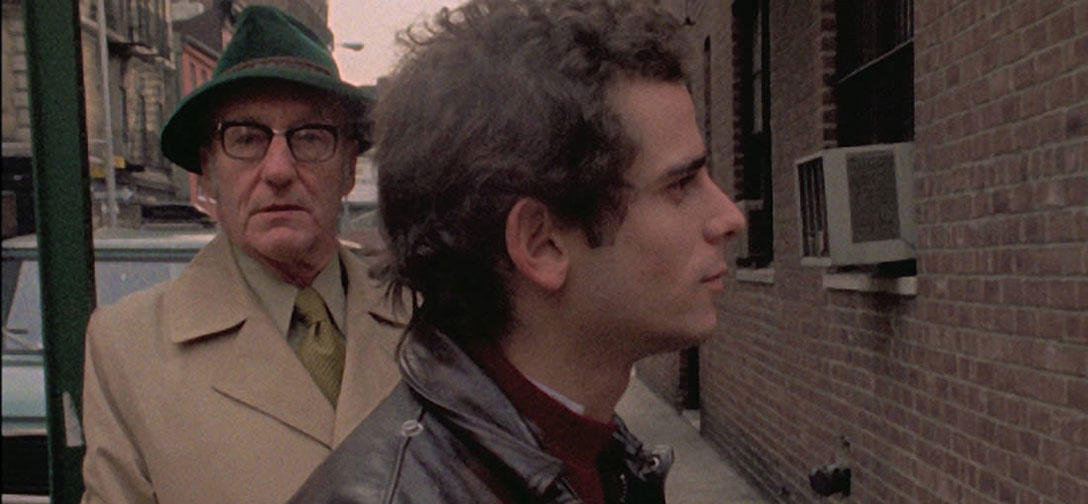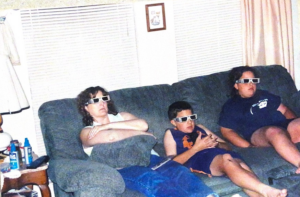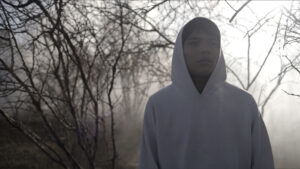Jeremy Kinser
Director Howard Brookner made his initial mark on the cinematic landscape in 1983 with Burroughs: The Movie, a widely praised look at legendary beat generation writer William S. Burroughs, which also served as a document of New York’s fabled downtown scene during what many consider its artistic heyday. Brookner’s follow-up was another acclaimed non-fiction film, 1986’s Robert Wilson and the Civil Wars, about the famed theater director. Two years later, Brookner made the switch to narrative filmmaking with Bloodhounds of Broadway, assembled from a quartet of Damon Runyon stories. The musical comedy generated a lot of attention at the time for its pedigreed cast, which included Madonna and Matt Dillon. Unfortunately, its director didn’t live to see its release.
Howard’s nephew Aaron, who was a mere seven when his uncle passed away became even more fascinated with him while working on a remaster of his seminal Burroughs doc. After deciding to make a film of his own about Howard’s unique career, Aaron found a treasure trove of outtakes from the 1983 film at the iconic writer’s well-preserved bunker in Manhattan. He’s incorporated that footage along with a video diary Howard presciently recorded during his final months. The result is Uncle Howard, a loving valentine to his uncle’s unique career and an unflinching look at an artistic community under crisis.
Brookner spoke with Sundance about the challenges in making a documentary about a member of his family and his uncle’s lasting legacy.
This is obviously a very personal film for you. How did it begin for you?
It began in many different ways. My interest in my uncle went a long way back to when I was a kid. He was a very important person in my life and introduced me to film. Later on, this project began in wanting to know why his films weren’t better known and where they were. There was also this feeling that New York was changing so much — the New York of my childhood, that I’d experienced with my uncle. Films aren’t going to preserve themselves. Stories and legacies won’t continue on unless someone takes some initiative in sharing them. That was the emotional impetus for beginning this journey. It started with going to look at Howard’s first film, which was the 1983 documentary about William Burroughs, which had essentially been missing since he died of AIDS in 1989.
How do you maintain a level of objectivity when making a film about a subject you were close to personally, which also involves interviewing your own family members?
From a directing point of view it was a real challenge. For the film to work I’d have to put the audience in my own headspace, which is a kind of childlike inquisitiveness in a way. There was this sense of awe and wonder that I was really experiencing the further I delved into Howard’s story and the material he left behind. I tried to stay focused on two elements: Where was his stuff and what was his story? It would inevitably veer into more personal things and it became very emotional to tackle all of that. I’d shift a little bit back to this place where it was more pure and fun. It felt like that’s where I was actually channeling Howard. Howard is not in all of this sadness and nostalgia. He doesn’t exist in that place. He exists as a very vibrant young man who was very excited about life and having a lot of fun. This became very apparent, especially when I watched the outtakes from the Burroughs film and his Bloodhounds film. He was having fun living his life and doing his thing. When it started to drift emotionally into a different direction I’d slide back. That’s not to say I’d shy away from the hard parts of his story because they’re in there, but Howard’s spirit was so uplifting. I was trying to channel that all the time as the main focus.

It’s a frank portrait of your uncle. You even go so far as to show photos of him shooting up heroin. How did you decide what you’d include?
Of course, there’s always a consideration for what others might feel, but I had no agenda. For example, with the heroin I was at Howard’s friend Stu Myers’ place and he said he had these old books. I said I’d come over and look at them and film it. I really didn’t know what would happen. I was just there, turning the pages and there was my uncle with a bag of dope on the table with a needle in his arm. I was like “Moving on…” He doesn’t look like a junkie. That was all in real time. If it happened and it was part of his story and part of the natural discovery, then I felt OK about it and it felt like another layer of Howard’s story and looked at in a non-judgmental way. That’s what I meant about keeping the perspective of being the child that I was. What sets my experience apart from others in the family and from his friends is that to me Howard always seems big. I’m always seven years old looking up at him in his early thirties and full of wonder. I tried to think for years about why the presence of Howard had such a stronghold over me. He was frozen like that. I kept growing but he stayed as big in my mind. I was thinking of that perspective. I’m happy with the balance we found.
He kept a video diary during the last months of his life. Do you think he wanted this footage to be seen by people?
This was not the age of self-documentation so one has to think that in the mid-‘80s if you get a video camera and you make a point to turn it on yourself then yeah. I wouldn’t say this, but some people have said “Howard left this footage for you to find to tell his story.” Maybe that’s true or maybe it’s not. I do think the act of self-documentation is possibly his way to be seen or his way of making sure his story was put down, making sure this moment of his life that he shared with so many friends was put down on record. I feel it is there for the record so if one such as myself comes along and wants to look at it, it’s great that it’s available for us to understand what it was like.
You had a perception of Howard based on your own memories and your family’s stories. How different was it from the person you discovered while making this film?
It wasn’t different. I’d just say it was more. Finally, I had the image to put to this larger-than-life persona. I really looked up to him as a little kid and had these amazing memories with him and at times I wasn’t sure why. Then I found these home movies and realized the amount of time we spent together with a video camera. I hadn’t remembered he gave me a video camera. Then it started to come back. An interesting thing about looking through the camera is it really concentrates the mind on that moment in a way that doesn’t normally happen. I’d say if anything, he grew into this larger-than-life memory and these pretty varied escapades he went on in his life… they were new and exciting but they always made sense. They were always more Howard. They were the perfect mixture of mischievousness and fun and intelligence but not highbrow. This was the kind of aura around Howard. It was kind of a gratifying experience that all of these things backed up the impression I had of this important childhood figure.
Howard gave you your first camera when you were a young boy. How did he encourage you to use it?
He encouraged me to explore it. At first it was a device he was using on me to just talk to me and pay attention. He was really interested in what I was building on my grandma’s back deck, for example, or talking about a toy gun. It was just a way of exploring conversation and a personal interest. It gave me a very comfortable feeling. Then I got interested in “What’s this device that’s capturing things?” Then he showed me how to aim it and use it. In a way, the camera is wrapped up in this very warm memory that everyone has in their childhood when they think of a figure that was really interested in them and was full of love. It gave that to me in a way. Ever since then the idea of making films, focusing on something and wanting to point a camera there and record it has been a very warm familial feeling, one of great satisfaction. He really gave me that.
You discovered 35 hours of outtakes footage from Howard’s documentary on William Burroughs that had been stored in Burroughs’ bunker in New York. How did you learn about it?
When I began to look for a negative or print of the Burroughs film I got together with Jim Jarmusch, who did the sound on the film, Sarah Driver, who was Howard’s great friend and who was very instrumental in the recovery of the Burroughs film, and John Giorno, who lived at the bunker and was involved in releasing the early VHS copy of the film and James Grauerholz, who was the heir of Burroughs. We’d been searching all over the place then James produced this inventory he had ofHoward’s archive that was stored at the bunker, unbeknownst to all of us. That’s how I learned about it. You see it in the film. It’s a wall of cans.
This footage must have been a godsend as it helps illuminate not only Howard’s work, but aspects of his life and social circle. Could you have made this film without it?
It would have been different. I think what happened was it became much bigger. Finding that archive opened up the story to other levels. It opened it up to a story about New York at this amazing point in counter-culture history. By extension, this other footage that came forward like his video diary and the behind-the-scenes footage of his films started to create this whole world. It wasn’t just remembering the guy, it was being able to see the whole world that existed. It was a story about New York and AIDS and what it means to know you’re going to die and how you choose to live your life. All of these things metaphorically were buried in an archive. I would have made the movie anyway, but I don’t think it would have reached such a large place because ultimately film is about being able to show the whole world. That’s why you pay to see a movie, to get lost on another planet for 90 minutes. That’s what happened with finding the footage in the bunker. I could time-travel into Howard’s world and take an audience there.
In your film, Jim Jarmusch describes Howard as “inscrutable.” After making a film about him, how would you describe him?
This is an amazing thing. Howard was a different person to everyone who knew him. No one knew the same Howard and yet everyone knew the same Howard. I’d say he’s just totally, totally Howard. There’s no other way to describe him. He lived so many lives in such a short period of time. He was so consistently him and yet so much like a chameleon. I’ve no one to compare him to. When I’ve discussed him with Jim or Sarah or Tom DiCillo or Brad Gooch or Frederic Mitterrand, no one can think of a character quite as complicated or sincere as Howard. It’s very interesting.
After making his two documentaries, Howard switched gears to direct the narrative feature Bloodhounds of Broadway. How did he get such high-profile cast with Madonna and Matt Dillon?
That was the power of Howard. [Laughs] Here’s a guy who at 24 years old was able to understand William Burroughs and his ideas and relate to him and get to know him so well and make a film about him. Then he did the same thing with Robert Wilson, who was a different but equally complex character. Then we went to Hollywood and on a pretty low budget get all these actors. Madonna worked for scale. There’s a great line I heard. Madonna’s agent called up furious. “You’ve got Madonna working for nothing! And you’ve got her singing! And you’ve got her dancing!” [Laughs] At the end of the day the reason he left such an impact on us is he was so sincere that he could relate to different kinds of people and find this common thread of humanity and humor and joie de vivre. It’s universal. It goes from Burroughs to Robert Wilson and to the Hollywood system. Actors and producers and crews were all very excited about Howard’s enthusiasm for filmmaking and his vision and his enjoyment of life.
What message are do you want viewers to take from the film?
There are so many things that we worked brutally hard to layer into this film so there would be different angles and elements that people can relate to. Already I’ve seen it with different audiences from different backgrounds and they’re finding common threads. I’m happy for people to take whatever they want from the film. I think if there’s an overarching message from Howard himself, it’s in the form of the kind of works he leaves. Life is short. To me it was very powerful to see Howardyoung and healthy on his 33rd birthday about to embark on his dream Hollywood film production in a room packed with friends. A year after that he’s losing his vision. A year after that he’s in the grave. It can all turn so quickly. Because Howard made the most of his time, he got a lot out of life. William Burroughs used to say that time is a resource. Use your time wisely and get the most you can out of life because you don’t know when it will end.




